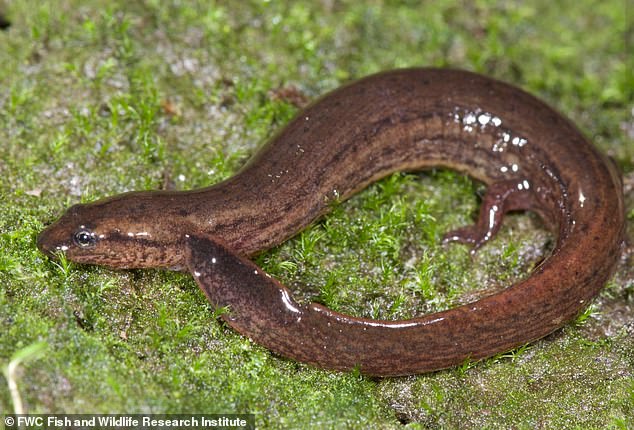A rare amphibian once thought to have vanished from Florida has been found alive – more than three decades after its last documented sighting.
Researchers waded through murky, blackwater streams in the state’s northern wetlands and emerged with a remarkable discovery: nearly two dozen many-lined salamanders, a species not seen in Florida since 1991.
The surprising find is detailed in a new study published in The Florida Field Naturalist by the Florida Ornithological Society, marking the first confirmed sightings of the elusive creature in 33 years.
‘In general, we know relatively little about this salamander, but it has likely been impacted by the loss of wetland habitats throughout its range,’ the study authors wrote.
Native to coastal regions from northeast Florida to Virginia, the many-lined salamander had previously only been found in four Florida counties – Baker, Columbia, Nassau and Union – before seemingly vanishing.
According to the Florida Fish and Wildlife Conservation Commission (FWC), the species sits at the southernmost edge of its range.
Often described as ‘secretive’ and mostly aquatic, the salamander remains rare even in areas where it is known to live, herpetologists at the University of Georgia say.
The FWC’s Fish and Wildlife Research Institute partnered with the North Carolina Wildlife Resources Commission and a private timberland company to launch a multi-year survey to determine whether the amphibian still called Florida home.

The many-lined salamander, once thought to have vanished from Florida, was recently spotted for the first time in over 30 years

A total of 23 salamanders were found across two Florida forests – 17 in Osceola National Forest and six in John M. Bethea State Forest. Pictured: a file photo of Florida wetlands
Between 2022 and 2024, researchers scoured more than a dozen blackwater stream sites across north Florida, hoping to uncover any trace of the cryptic creature.
‘In 2022, we searched for salamanders using a variety of aquatic amphibian survey techniques, including dredging, dip-netting and hand raking, to conduct regular time-based surveys at each site,’ the authors wrote.
But high water levels made some habitats impossible to probe – so the team got creative.
They devised a novel technique using mesh bags filled with decaying leaves, placed on stream bottoms to mimic the mucky, debris-laden conditions the salamanders are thought to prefer.
The creatures could crawl inside and hide, with researchers checking the bags regularly.
In the end, they struck gold at just two locations: 17 salamanders were found in Osceola National Forest, and another six in John M. Bethea State Forest. Of the 23 discovered, eight were adults.
Despite the breakthrough, researchers say it’s still unclear how stable the population is.

Florida marks the southernmost tip of the many-lined salamander’s range, making sightings there exceptionally rare
‘The species has long been considered rare in Florida and difficult to survey,’ according to the paper.
‘It is likely that the many-lined salamander has always been relatively uncommon in Florida, where it reaches the southern extent of its geographic range.’
The salamander is listed as a species of greatest conservation need in Florida, and experts warn its fragile numbers could face further threats from climate change and habitat destruction.
‘Species that occur on the periphery of their range are seldom prioritized for conservation action,’ the study authors noted.
‘Still, many-lined salamanders are a unique component of Florida’s natural heritage.’
This article was originally published by a www.dailymail.co.uk . Read the Original article here. .

